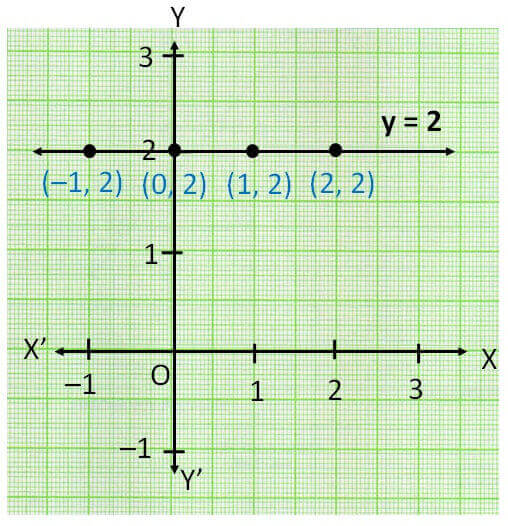Parallel to x-axis: All horizontal lines are parallel to the x-axis and they have a slope of 0. When a line is perpendicular to y-axis, it is parallel to the x-axis. In both cases:
m = 0
An equation such as y = 2 can be graphed in the coordinate plane. Any pair of values whose y-coordinate is 2, no matter what the x-coordinate is, makes the equation y = 2 true. Therefore,(-3, 2), (-2, 2), (-1,2), (0, 2), (1,2),or any other pair (a, 2) for all values of a, are points on the graph of y = 2.

The equation of a line that is parallel to the x-axis and is b units away from the x-axis is y = b. If b is a +ve number, then the line is above the x-axis, and if b is -ve, the line is below the x-axis.
Parallel to y-axis: All vertical lines are parallel to the y-axis and they have an undefined slope.When a line is perpendicular to the x-axis, it is parallel to the y-axis. In both cases:
m = undefined
An equation such as x = 1 can be graphed in the coordinate plane. Any pair of values whose x-coordinate is 1, no matter what the y-coordinate is, makes the equation x = 1 true.Therefore,(1, —2), (1, —1), (1, 0), (1,1), (1, 2),or any other pair (1, b) for all values of b, are points on the graph of x = 1. As shown below, the graph of x = 1 is a vertical line parallel to the y-axis and 1 unit to the right of it.The equation x = 1 defines a relation that is not a function because it
defines a set of ordered pairs but every ordered pair has the same first element.

The equation of a line that is parallel to the y-axis and ‘a’ units away from the y-axis is x = a. If a is +ive, the line is to the right of the y-axis, and if a is -ive, the line is to the left of the x-axis.
For example:
- Write an equation of the line that is parallel to the y-axis and passes through the point (-4, 2). Ans. Since the slope is undefined, the equation of the line is x=-4
- Write equations of the horizontal and vertical lines that pass through (-1/4, 7) Ans. Horizontal: y = 7, Vertical: x = -1/4